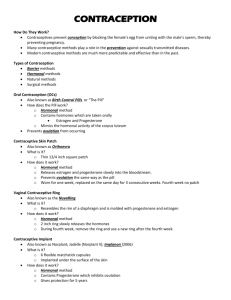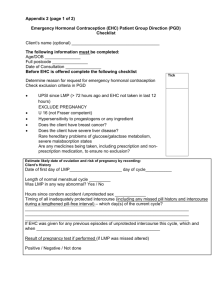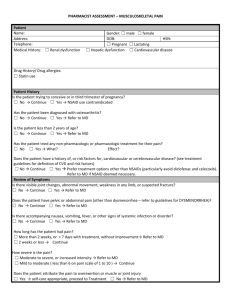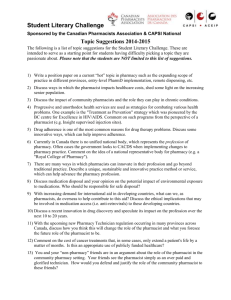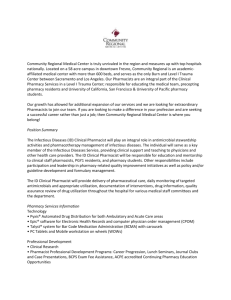Form - Community Pharmacy Foundation
advertisement
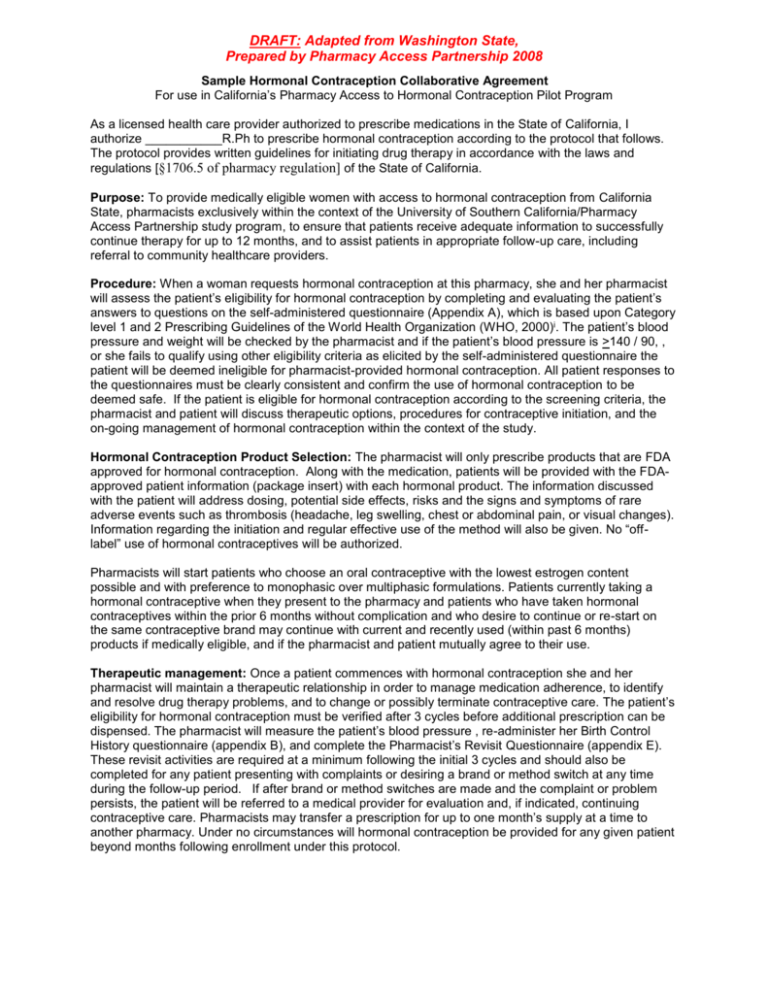
DRAFT: Adapted from Washington State, Prepared by Pharmacy Access Partnership 2008 Sample Hormonal Contraception Collaborative Agreement For use in California’s Pharmacy Access to Hormonal Contraception Pilot Program As a licensed health care provider authorized to prescribe medications in the State of California, I authorize ___________R.Ph to prescribe hormonal contraception according to the protocol that follows. The protocol provides written guidelines for initiating drug therapy in accordance with the laws and regulations [§1706.5 of pharmacy regulation] of the State of California. Purpose: To provide medically eligible women with access to hormonal contraception from California State, pharmacists exclusively within the context of the University of Southern California/Pharmacy Access Partnership study program, to ensure that patients receive adequate information to successfully continue therapy for up to 12 months, and to assist patients in appropriate follow-up care, including referral to community healthcare providers. Procedure: When a woman requests hormonal contraception at this pharmacy, she and her pharmacist will assess the patient’s eligibility for hormonal contraception by completing and evaluating the patient’s answers to questions on the self-administered questionnaire (Appendix A), which is based upon Category level 1 and 2 Prescribing Guidelines of the World Health Organization (WHO, 2000)i. The patient’s blood pressure and weight will be checked by the pharmacist and if the patient’s blood pressure is >140 / 90, , or she fails to qualify using other eligibility criteria as elicited by the self-administered questionnaire the patient will be deemed ineligible for pharmacist-provided hormonal contraception. All patient responses to the questionnaires must be clearly consistent and confirm the use of hormonal contraception to be deemed safe. If the patient is eligible for hormonal contraception according to the screening criteria, the pharmacist and patient will discuss therapeutic options, procedures for contraceptive initiation, and the on-going management of hormonal contraception within the context of the study. Hormonal Contraception Product Selection: The pharmacist will only prescribe products that are FDA approved for hormonal contraception. Along with the medication, patients will be provided with the FDAapproved patient information (package insert) with each hormonal product. The information discussed with the patient will address dosing, potential side effects, risks and the signs and symptoms of rare adverse events such as thrombosis (headache, leg swelling, chest or abdominal pain, or visual changes). Information regarding the initiation and regular effective use of the method will also be given. No “offlabel” use of hormonal contraceptives will be authorized. Pharmacists will start patients who choose an oral contraceptive with the lowest estrogen content possible and with preference to monophasic over multiphasic formulations. Patients currently taking a hormonal contraceptive when they present to the pharmacy and patients who have taken hormonal contraceptives within the prior 6 months without complication and who desire to continue or re-start on the same contraceptive brand may continue with current and recently used (within past 6 months) products if medically eligible, and if the pharmacist and patient mutually agree to their use. Therapeutic management: Once a patient commences with hormonal contraception she and her pharmacist will maintain a therapeutic relationship in order to manage medication adherence, to identify and resolve drug therapy problems, and to change or possibly terminate contraceptive care. The patient’s eligibility for hormonal contraception must be verified after 3 cycles before additional prescription can be dispensed. The pharmacist will measure the patient’s blood pressure , re-administer her Birth Control History questionnaire (appendix B), and complete the Pharmacist’s Revisit Questionnaire (appendix E). These revisit activities are required at a minimum following the initial 3 cycles and should also be completed for any patient presenting with complaints or desiring a brand or method switch at any time during the follow-up period. If after brand or method switches are made and the complaint or problem persists, the patient will be referred to a medical provider for evaluation and, if indicated, continuing contraceptive care. Pharmacists may transfer a prescription for up to one month’s supply at a time to another pharmacy. Under no circumstances will hormonal contraception be provided for any given patient beyond months following enrollment under this protocol. DRAFT: Adapted from Washington State, Prepared by Pharmacy Access Partnership 2008 Stopping Prescription and referrals: The pharmacist will stop the patient’s hormonal contraceptive and refer the patient to see a physician or other family planning clinic provider if the patient experiences new or persistent side effects or complaints, including hypertension, weight > 200 pounds, irregular bleeding after 3-months of hormonal contraceptive use and/or if pregnancy is suspected. Additionally, patients will be referred if the pharmacist identifies any other barriers to use of new or on-going contraceptives, such as the patient’s inability to afford the method. If there is a concern that the patient may be at risk for or could have contracted a sexually transmitted disease through unprotected sex, and/or if the patient indicates that she has been sexually assaulted, the pharmacist will initiate appropriate referral. Documentation and quality assurance: Each prescription authorized by the pharmacist will be documented in a patient profile as required by law. The self-administered questionnaire will be used to inform the profile and will be retained at the study site as a patient record for reference by the pharmacist in managing the patient On a quarterly basis, the authorizing prescriber and the pharmacist will perform a quality assurance review of the prescribing decisions with respect to appropriateness of method selected. The pharmacist(s) who participate in the protocol must have completed training covering the procedures listed above, and the management of the sensitive communications often encountered in the provision of hormonal contraception. The prescriptive authority is granted for a period of two years from the date of approval, unless rescinded in writing earlier by either the authorizing prescriber or the pharmacist. Signatures: Authorizing Prescriber ___________________ License# __________License Date Authorized Pharmacist ___________________ License #__________ License Date ______________ i World Health Organization (WHO) 2000. Improving Access to Quality Care in Family Planning: Medical Eligibility Criteria for Contraceptive Use. Second edition. Geneva: WHO 2000.
